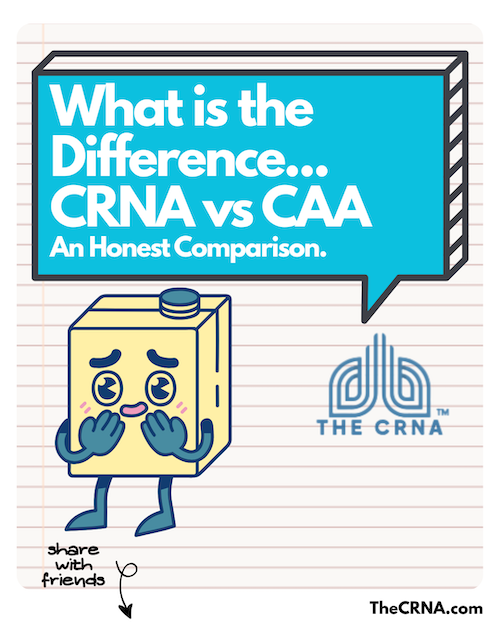
1. Education & Entry Pathways
Certified Registered Nurse Anesthetist (CRNA): The CRNA journey begins with earning a Bachelor of Science in Nursing (BSN) and obtaining a license as a Registered Nurse (RN). Candidates must gain at least one year of experience in a high-acuity Intensive Care Unit (ICU), though most successful applicants have two or more years of bedside experience. This ICU background builds critical thinking, invasive monitoring, and rapid response skills vital to anesthesia practice. Applicants often submit GRE scores and may hold additional credentials such as CCRN certification to strengthen competitiveness. The final step is completing a Doctor of Nursing Anesthesia Practice (DNAP) or Doctor of Nursing Practice (DNP) program, typically lasting 3–4 years and including both classroom and extensive clinical rotations. Graduates then pass the National Certification Examination (NCE) to become licensed CRNAs.
Certified Anesthesiologist Assistant (CAA): The CAA route begins with a bachelor’s degree in science (biology, chemistry, or similar) and completion of medical school–level prerequisites such as organic chemistry, physics, and physiology. Nursing licensure and ICU experience are not required. Students then enter an accredited Master of Science in Anesthesia (MSA) or Master of Medical Science in Anesthesia (MMSc-A) program, which generally lasts 2–3 years and combines didactic coursework with clinical rotations under anesthesiologist supervision. Graduates must pass the National Commission for Certification of Anesthesiologist Assistants (NCCAA) exam and complete ongoing CME and recertification every six years.
2. Scope of Practice & Job Flexibility
CRNAs: CRNAs are legally recognized in all 50 states and serve in every branch of the military. In more than 20 “opt-out” states, CRNAs may practice independently without anesthesiologist supervision. Their scope includes anesthesia for surgery, labor and delivery, trauma, and pain management across hospitals, ambulatory centers, dental offices, and rural clinics. Some CRNAs become independent business owners or 1099 contractors, offering services directly to facilities and building group practices.
CAAs: CAAs are legally recognized in about 20 states, with roughly 13–15 maintaining active employment markets. They must always work under the Anesthesia Care Team (ACT) model directed by a physician anesthesiologist. This structure creates consistent, team-based collaboration but limits autonomy and restricts practice to approved states and facilities. CAA positions are most common in large hospital systems, academic medical centers, and teaching institutions.
3. Job Market, Regulation & Politics
The anesthesia field involves significant professional advocacy and political tension. The American Association of Nurse Anesthesiology (AANA) represents CRNAs and promotes independent practice and equal recognition as anesthesia providers. In contrast, the American Society of Anesthesiologists (ASA) supports physician-led anesthesia care and helped establish the CAA profession to work exclusively within this model. As a result, lobbying competition between these groups can influence state legislation, hiring practices, and facility policies. Some CRNA-dominated groups may avoid hiring CAAs even where legal, while physician-led groups may prefer CAAs for the ACT structure. Ongoing state-by-state advocacy continues to shape both professions’ future access and growth.
4. Pay & Career Outlook
CRNAs: National surveys report average earnings between $190,000 and $250,000 per year for staff roles, with locum tenens, 1099, and independent contractors earning substantially more—often exceeding $300,000 in high-demand or rural areas. CRNAs who own or join private anesthesia groups may surpass these figures through profit sharing or direct facility contracts.
CAAs: CAA salaries are also competitive, typically ranging from $150,000 to $210,000+ depending on region, institution type, and experience. Because CAAs cannot practice independently, compensation growth is generally tied to experience and institutional pay scales rather than entrepreneurship. Locum opportunities exist but are limited compared with the CRNA market. Both professions enjoy strong job stability due to increasing surgical volume and an aging population requiring more anesthesia services.
5. Lifestyle & Work Environment
Day-to-day responsibilities can be similar for CRNAs and CAAs — administering anesthesia, managing airways, and ensuring patient stability throughout procedures. The key differences stem from employment models and autonomy.
- CRNAs: Can choose from W-2 hospital positions with predictable hours, or 1099 and locum roles offering higher pay and flexibility. Many CRNAs enjoy scheduling freedom and geographic mobility, working in rural, outpatient, or travel assignments nationwide.
- CAAs: Typically work standard hospital schedules (often Monday–Friday) under anesthesiologist supervision.
6. Other Key Considerations
- Training Duration: CRNA preparation takes longer (BSN + ICU + 3–4-year doctorate) but results in broader flexibility. The CAA pathway is shorter if starting from a science background.
- Mobility: CRNAs can practice nationwide; CAAs are limited to approved states.
- Age & Timing: Students commonly graduate between their late 20s and late 30s. Admissions committees value maturity and clinical experience over age.
- Long-Term Growth: CRNAs can advance into education, administration, or practice ownership. CAAs maintain steady, physician-supervised roles.
7. Accuracy Check
- CRNAs: Legal in all 50 states; independent practice varies by state and facility.
- CAAs: Recognized in roughly 20 states; must always work under anesthesiologist supervision.
- Salaries: Both can be competitive; CRNAs generally have higher earning ceilings due to autonomy and locum options.
- Politics: Ongoing advocacy from AANA and ASA continues to shape both professions.
The CRNA career path is for you if you value maximum independence, flexibility, and earning potential and are willing to invest in the longer training that includes nursing and ICU experience. The CAA career path may be for you if you prefer a shorter route, are willing to always work within the ACT model, and plan to live in a state that authorize CAA practice.


